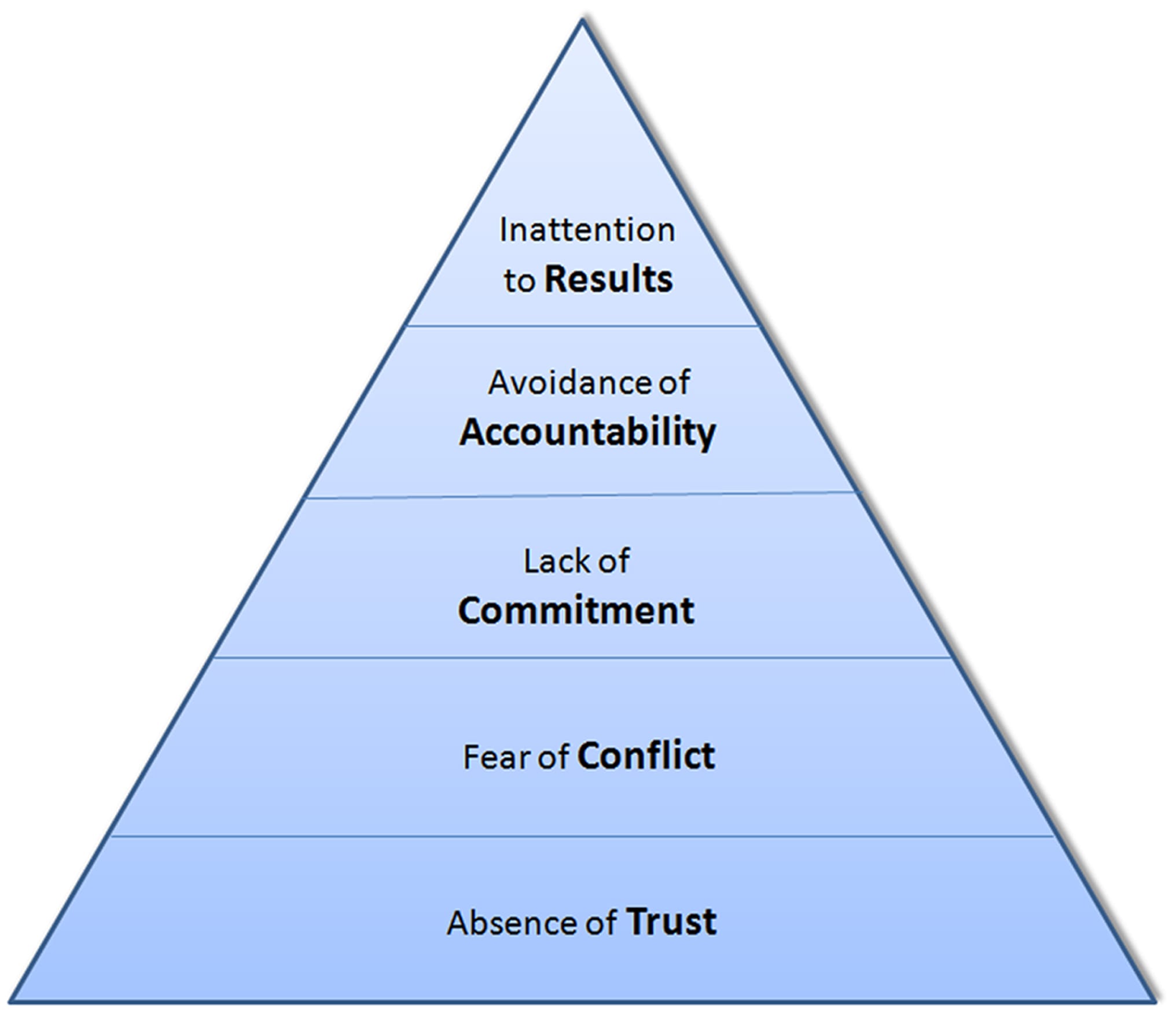Have you ever been part of a team that felt like a group of talented individuals paddling in different directions? Despite everyone’s hard work, the boat just wasn’t moving forward. You might have been experiencing the five dysfunctions of a team, a model developed by Patrick Lencioni, which can be visualized as a pyramid, with each level impacting those above it. This guide offers a practical, actionable approach to understanding and overcoming these common team pitfalls.
Decoding the Dysfunction Pyramid
Team dysfunction isn’t a personality clash; it’s a predictable, addressable pattern. Patrick Lencioni’s “Five Dysfunctions of a Team” model, visualized as a pyramid, provides a framework for understanding and overcoming these obstacles. The foundation, and arguably the most crucial element, is trust. More specifically, the absence of trust. This isn’t about sharing personal secrets; it’s about fostering vulnerability. Can team members admit mistakes without fear of judgment? If not, a lack of trust likely impacts every other aspect of team performance.
[Visual representation of the Five Dysfunctions Pyramid would be inserted here]
Climbing to Team Success: Addressing Each Dysfunction
So, how do we build a truly high-performing team? We tackle each dysfunction step-by-step, starting from the base of the pyramid.
1. Building Trust: The Foundation of Teamwork
Vulnerability is the bedrock of trust, the foundation upon which high-performing teams are built. Genuine trust doesn’t appear overnight. It requires cultivating a culture of openness and honesty. While team-building activities can help, real trust grows from shared experiences, both professional and personal (within appropriate boundaries). Encourage open communication and celebrate both successes and failures, demonstrating that it’s okay to be human.
2. Embracing Conflict: Healthy Debates, Not Drama
Once trust is established, teams can embrace conflict. This isn’t about personal attacks; healthy conflict involves debating ideas, challenging assumptions, and respectfully disagreeing. Establish ground rules: focus on the issue, not the individual. Encourage diverse perspectives, recognizing that differing viewpoints often lead to innovative solutions.
3. Fostering Commitment: Clarity and Buy-In
Without healthy conflict, achieving genuine commitment becomes challenging. If concerns and ideas haven’t been voiced, individuals are less likely to fully invest in decisions. Clear decision-making processes are essential. Ensure everyone understands the process and feels heard. Documenting agreements and encouraging open commitment strengthens buy-in.
4. Encouraging Accountability: Shared Responsibility
Accountability isn’t about blame; it’s about shared commitment to team results. This can be tricky, but accountability is essential for high performance. It begins with clear expectations and performance standards. Regular progress reviews and, perhaps more importantly, peer-to-peer accountability, foster a culture of excellence and mutual respect.
5. Focusing on Results: The Ultimate Objective
Finally, we reach the top of the pyramid: Results. While seemingly obvious, it’s easy to lose sight of overarching goals amidst daily tasks. Define clear, shared objectives and use measurable metrics to track progress. Regular reviews and shared celebrations of achievements reinforce the collective nature of success.
The Five Dysfunctions: A Deeper Dive and Practical Solutions
Let’s examine each dysfunction in more detail, exploring its impact and potential solutions.
| Dysfunction | Description | Impact |
|---|---|---|
| Absence of Trust | Team members are reluctant to be vulnerable and open with one another. | Hinders open communication, collaboration, and the ability to address issues effectively. |
| Fear of Conflict | Teams avoid productive conflict and disagreements, leading to superficial harmony. | Stifles creativity, prevents thorough consideration of alternatives, and allows resentment to fester. |
| Lack of Commitment | Teams struggle to reach decisions and fully commit to them, hindering progress. | Leads to missed opportunities, wasted effort, and a lack of direction. |
| Avoidance of Accountability | Team members hesitate to hold each other accountable for their actions and performance. | Fosters a culture of underperformance and missed deadlines. |
| Inattention to Results | Individual priorities and egos overshadow the team’s collective goals. | Prevents the team from achieving its full potential and delivering optimal results. |
Practical Solutions:
- Trust-Building Exercises: Use structured activities to foster vulnerability and open communication. Consider personality assessments (like Myers-Briggs) to help team members understand each other’s working styles and communication preferences.
- Conflict Resolution Training: Equip team members with the skills to engage in healthy conflict, focusing on active listening and respectful communication.
- Commitment-Building Workshops: Facilitate workshops focused on collaborative decision-making and developing shared goals.
- Accountability Systems: Implement clear performance metrics and regular feedback mechanisms. Consider peer-to-peer feedback tools or 360-degree assessments.
- Results-Oriented Meetings: Structure meetings to focus on progress towards shared goals. Use data visualization tools to track performance and celebrate achievements.
The Five Dysfunctions in Meetings: Recognizing the Patterns
The five dysfunctions often manifest clearly in team meetings. Recognizing these patterns helps pinpoint areas for improvement.
| Dysfunction | What it looks like | What it means for the team |
|---|---|---|
| Absence of Trust | People hold back, hesitant to share or ask for help. | Superficial discussions, ineffective solutions |
| Fear of Conflict | Avoiding disagreements and challenges. | Missed opportunities, “groupthink” |
| Lack of Commitment | Half-hearted efforts, missed deadlines. | Stalled projects, lack of motivation |
| Avoidance of Accountability | “It’s not my job” mentality, low performance. | Mediocrity becomes the norm, lack of growth |
| Inattention to Results | Individual agendas over team goals. | Missed targets, wasted resources, disillusionment |
The Ongoing Journey of Team Development
Mastering the five dysfunctions is a continuous process, not a one-time fix. Team dynamics evolve, research in this area progresses, and what works today may need adjustments tomorrow. Regularly assess your team’s health, be open to adaptation, and remember that each team is unique. There’s no single solution, so be prepared to experiment and find what works best for your team.
If you’re preparing for the HESI A2 entrance exam, this guide will provide you with valuable tips and strategies. Thinking about joining an elite sports league? Check out these highschool hoops demo codes.
- Unlock Elemental 2 Secrets: Actionable Insights Now - April 2, 2025
- Lot’s Wife’s Name: Unveiling the Mystery of Sodom’s Fall - April 2, 2025
- Photocell Sensors: A Complete Guide for Selection and Implementation - April 2, 2025
















